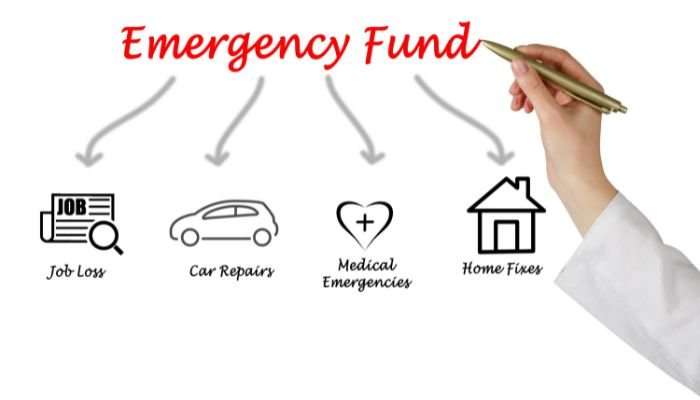Disclaimer: This post may contain affiliate links, meaning we get a small commission if you make a purchase through our link at no extra cost to you. For more information, please visit our Disclaimer Page.
Starting an emergency fund might seem overwhelming, but it’s one of the smartest financial decisions you’ll ever make.
Life throws unexpected challenges our way—job loss, medical bills, car repairs—and having a safety net can keep you afloat.
This isn’t about saving massive amounts overnight; it’s about taking small, consistent steps toward financial security.
By budgeting some money aside even a little each month, you’ll create a cushion that protects you from future stress.
In this guide, we’ll break down simple strategies for building your emergency fund, making it easier than ever to get started.
What is an Emergency Fund?
An emergency fund is a financial cushion set aside to cover unexpected expenses.
It acts as a safety net, giving you peace of mind knowing you’re prepared for emergencies like medical bills, car repairs, or job loss.
With an emergency fund, you avoid resorting to debt or dipping into long-term savings.
Why You Need an Emergency Fund
Life is unpredictable. Emergencies aren’t a matter of “if” but “when.”
Without an emergency fund, unexpected expenses can derail your finances and increase stress.
Having one ensures financial stability and helps you focus on resolving the situation rather than worrying about money.
How Much Should You Save in Your Emergency Fund?
The amount you should save depends on your circumstances, but here’s a general guideline:
- Starter Fund: $1,000 for small emergencies like a broken appliance or minor car repair.
- Full Emergency Fund: 3 to 6 months of essential living expenses to cover larger disruptions like job loss or medical emergencies.
Living Expenses to Include:
- Rent or mortgage
- Utilities (electricity, water, internet, phone)
- Groceries
- Transportation (gas, public transit, car insurance)
- Insurance (health, car, home, etc.)
What to Exclude:
- Dining out
- Subscriptions (Netflix, Spotify, etc.)
- New clothes or entertainment
Example Calculation:
If your monthly essential expenses are $2,500:
- 3-month emergency fund: $2,500 x 3 = $7,500
- 6-month emergency fund: $2,500 x 6 = $15,000
| Living Expenses | Monthly Cost | 3 Months | 6 Months |
|---|---|---|---|
| Rent/Mortgage | $1,200 | $3,600 | $7,200 |
| Utilities | $300 | $900 | $1,800 |
| Groceries | $600 | $1,800 | $3,600 |
| Transportation | $200 | $600 | $1,200 |
| Insurance | $200 | $600 | $1,200 |
| Total | $2,500 | $7,500 | $15,000 |
How to Build an Emergency Fund Fast
Saving for an emergency fund may seem daunting, but these tips can help you build it quickly:
- Set a Clear Goal: Calculate how much you need (use our 6-month calculator below).
- Cut Unnecessary Expenses: Pause subscriptions, dine out less, and limit discretionary spending.
- Automate Savings: Set up automatic transfers to your savings account. Digit analyzes your spending and saves automatically.
- Sell Unused Items: Declutter and sell items you no longer need.
- Take on Side Gigs: Use freelancing, part-time jobs, or gig work to increase income.
- Redirect Windfalls: Use tax refunds, bonuses, or gifts to boost your fund.
How Long Does It Take to Build an Emergency Fund?
The time it takes depends on your savings rate and financial situation. Here’s an example:
- Goal: $15,000 (6 months of $2,500 living expenses)
- Savings per Month: $500
- Time to Save: $15,000 / $500 = 30 months (2.5 years)
Speed it up by saving more per month or using windfalls.
Where to Keep Your Emergency Fund
Your emergency fund should be safe, accessible, and earning some interest. Here are great options:
- High-Yield Savings Account (HYSA): Offers higher interest rates than traditional savings accounts.
- Examples: Ally Bank, Marcus by Goldman Sachs, CIT Bank
- Money Market Accounts: Similar to HYSAs with competitive rates.
- Certificates of Deposit (CDs): Suitable for funds you don’t need immediate access to.
Emergency Fund Examples
Here are a few scenarios where an emergency fund can save the day:
- Job Loss: Cover rent, groceries, and bills while job hunting.
- Medical Emergency: Pay for unexpected procedures or medications.
- Car Repairs: Replace a broken transmission without going into debt.
- Home Repairs: Fix a leaking roof or broken furnace.
Step-by-Step: Starting an Emergency Fund Calculator
- Determine Monthly Living Expenses: Add up all essential costs (rent, utilities, groceries, etc.).
- Set Your Target: Decide between a 3-month or 6-month fund.
- Break It Down: Divide the target by your monthly savings capacity to estimate how long it will take.
- Track Your Progress: Use a spreadsheet or savings tracker to stay motivated.
Download the Emergency Fund Excel Calculator
To make it easier for you, we’ve created an Excel sheet with a pre-filled example for examples of monthly expenses and space to input your numbers.
The excel template is below the table, just enter best email to send it to.
Here’s a quick template to calculate your emergency fund:
| Expense Category | Monthly Cost | 3 Months | 6 Months |
| Rent/Mortgage | |||
| Utilities | |||
| Groceries | |||
| Transportation | |||
| Insurance | |||
| Other Essentials | |||
| Total |
Tips to Save Money for Your Emergency Fund
Building an emergency fund doesn’t have to feel impossible. Here’s how you can save more money and even find ways to make your savings grow:
- Get Cash Back on Groceries: Earn money back on everyday grocery purchases, even healthy foods, with Ibotta. Plus, get $10 just for signing up!
- Lower Your Cell Phone Bill: Consider switching to Tello, where plans start at just $5/month. You can keep your current number, and the $19/month plan includes unlimited text, calls, and 4GB of data.
- Switch to a High-Yield Savings Account: Most traditional banks offer a measly 0.03% interest. Move your money into a CIT Bank account, which offers up to 1.70% APY, to make your emergency fund grow faster.
- Cancel Unused Memberships: Review your subscriptions for gyms, streaming services, or other memberships you no longer use and cancel them to free up extra cash.
- Save on Meal Planning: Simplify meal prep and save time and money with $5 Meal Plan. Get your first two weeks free.
- Reduce Monthly Bills: Lower your recurring expenses for cell phones, internet, cable, or insurance with Billshark. It helped me save $290 just by uploading a bill.
- Earn Cashback on Online Purchases: Use Ebates (now Rakuten) to get cash back when shopping online. Plus, they’ll give you $10 just for signing up.
- Find Coupon Codes Automatically: Install Honey to automatically apply the best coupon codes at checkout whenever you shop online.
- Cut Prescription Costs: Save money on your prescriptions with GoodRx, which helps you find the lowest prices at local pharmacies.
- Sell Unused Items: Declutter your home and sell items you no longer need on platforms like Decluttr or Poshmark. This can help you earn extra cash to put toward your emergency fund.
These strategies can help you find extra money in your budget to reach your emergency fund goal faster.
Start small, and every dollar saved can bring you closer to financial security.
These strategies can help you find extra money in your budget to reach your emergency fund goal faster.
Start small, and every dollar saved can bring you closer to financial security.
Free Printable Emergency Fund Savings Challenge
For your use and journey, I have created two templates for you to start your emergency fund challenge journey. one is for $25 each time until you hit mark.
The other is $10 a day until you hit that $1000 mark.
If you want me to customize something else, please let me know.
Final note
Taking the first step in starting an emergency fund might feel challenging, but it’s one of the most rewarding things you can do for your financial well-being. Even small contributions add up over time, giving you the peace of mind to handle life’s surprises without panic.
Focus on consistency. Automate your savings, cut unnecessary expenses, and treat your emergency fund as a priority. Think of it as building a safety net that protects your future self.
As you watch your fund grow, you’ll feel empowered and in control of your financial journey.
Start today. A little planning now will save you from a lot of stress later.
Do you have an emergency fund? How much do you have saved?
Like this post? Share it!





